Budget spend: 1740€. Impressions: 5.478M. Reach: 2.033M. Clicks: 199,870. Mission: Inform the people of Nepal about Stroke.
Well, you can definitely speak about a success if you read the numbers above out loud. The campaign is still running. But let’s start from the beginning.
The Nepal Stroke Project
The Nepal Stroke Project is a NPO (non-profit organization) with the mission to „Reduce The Burden Of Stroke In Nepal“. It is a cooperation of the University Hospital Heidelberg (Universitätsklinikum Heidelberg) Department of Neurology (Neurologie) and the Nepal Stroke Association, funded by the GIZ (Gesellschaft für Internationale Zusammenarbeit) as part of the Hospital Partnerships (Klinikpartnerschaften), with strong support by the WSO (World Stroke Organization) and the Angels Initiative.
To understand how serious this is, you should have a look at the team.
If you want to know more about the project, you should also have a look at their website: NepalStrokeProject.org
Very nice website – kudos to the designer 😉
Stroke? What is a stroke again? And is this a big issue?
I remember when I first seriously thought about stroke: I knew almost nothing. Yes, it is something with the brain. Yes infarction style, like with the heart, right? But is this a big deal? Like, does it happen often?
Hell yeah.
There are some huge numbers (f.e. 5,5 million deaths per year, 116 million days of healthy life lost per year) that are definitely crazy huge, but I can’t wrap my head around it. But there’s one number (well, it actually is a fraction), that made me understand:
1 in 4.
(People who will have a stroke in their lifetime)
1 in 4 people will have a stroke. Just think about that. Put all your family, partner, friends in a line and cross of every fourth. You are in that line too, btw. Let that sink in.
Stroke is a HUGE topic, and definitely not being talked about enough. So, let’s get a Public Awareness Campaign started, right?
What is Stroke Awareness
So the problem is, even though so many people are affected, not enough know anything about stroke. The knowledge you need to know (by ‚you‘ I’m also talking to YOU, dear reader!) is basically:
- How to prevent a stroke
- What a stroke looks like
- What to do when someone has a stroke
And these topics are fairly easy to cover. Let’s begin with the last: CALL AN AMBULANCE. Like, NOW! If you see somebody with a stroke, don’t drive yourself or wait if it’s getting better. Stroke is treatable! There is a 4-5 hour window from onset, and every minute earlier improves the chances of getting out better.
Recognizing a stroke is almost as simple, but this is where most of the harm happens: People (like my past self and maybe you) don’t recognize a stroke. So I’d be sitting next to my uncle, he’s telling me (with a little slurry voice) he has trouble lifting his arm (but it kinda works) and I’d tell him: „You should check that out at a doctor. You should go tomorrow!“
WRONG!
So if you think it’s a stroke, it’s time to act. (See above). And these are the signs of a stroke:

- Face
- Arms
- Speech
- Time
Half face hanging? One arm weak? Slurred speech? => Time to call.
But I want to avoid making this post about stroke knowledge. I want to talk about social media in public health. So I’m skipping the prevention part here and refer to this: nepalstrokeproject.org/the-basics-of-stroke (you can also calculate your risk there)
The issue with public health topics
Most of the biggest diseases have round about the same prevention (what people would call a „healthy lifestyle“). But this is so hard to implement because people just don’t care enough. Fighting diseases on the public health front with primary prevention by information is a hard fight.
But what can be done with a bigger impact is managing the acute and post-acute phase (both in the hospitals and by informing the public), and this is where there is a lot of room to improve in the case of stroke (not only in Nepal).
4 Pillars of the Nepal Stroke Project
One more time about the NSP, then we’ll get to the social media part, I swear!
So, the Nepal Stroke Project is based on four pillars:
- Quality Improvement
- Quality Monitoring
- Public Awareness
- Stroke Care Policy
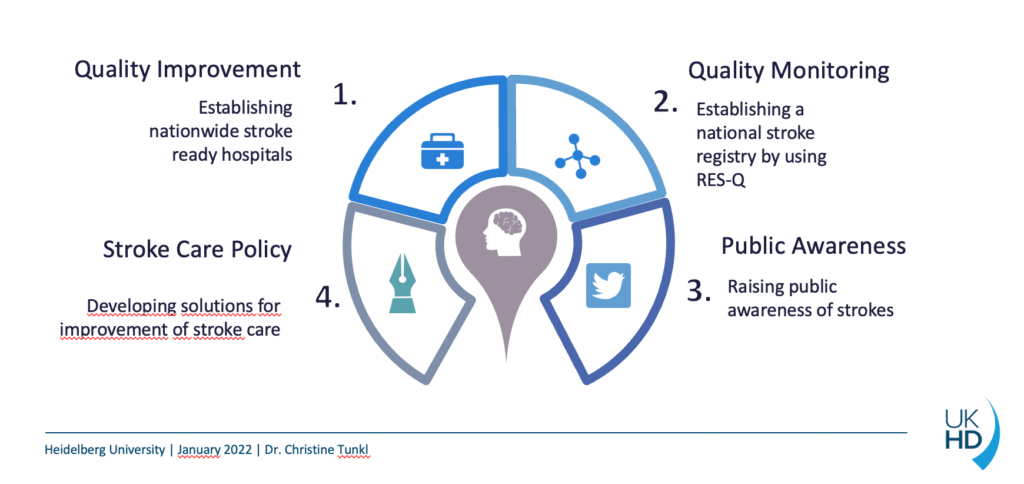
The first two are mostly „in the hospitals“: Medical staff is trained in workshops in stroke care and encouraged to collect the data. The last one is „for politics“, this is where the government has to be made aware of the situation and will hopefully respond accordingly.
And the third point is „for the people“. Here, the goal is to get the basic knowledge about stroke (mentioned above) to as many people as possible. SO here we go:
The Public Awareness Campaign
So to achieve the aim of bringing knowledge to the people, we made a short one-pager with basic information on stroke in Nepali and English as a goal for the campaigns.
While there is already information in the materials we used for the creatives (‚FAST‘), our main goal was to get the people to read the one-pager.
(Online vs. Offline: We also did offline campaigns and there are still more things to come, but in this article I’ll only talk about the online campaign.)
Channel selection and first test runs
We use Twitter, Facebook, Instagram and TikTok as social media channels for the project, so in the beginning all of those were in the short list for a paid ads campaign. SEA (Google Search, Bing…) was not to reduce complexity and also because a public awareness campaign should not be based on information pull, a huge difference to „sales“ or conversion campaigns. I mean, if people don’t know that stroke is important, they’ll unlikely google for the word ’stroke‘.
TikTok Ads is not available in Nepal, Twitters‘ Nepal user base is small, so we started with a small test run in the Meta network (a simple „Post Boost“ on Facebook – usually not the sharpest weapon of choice), and boy was this a surprise:
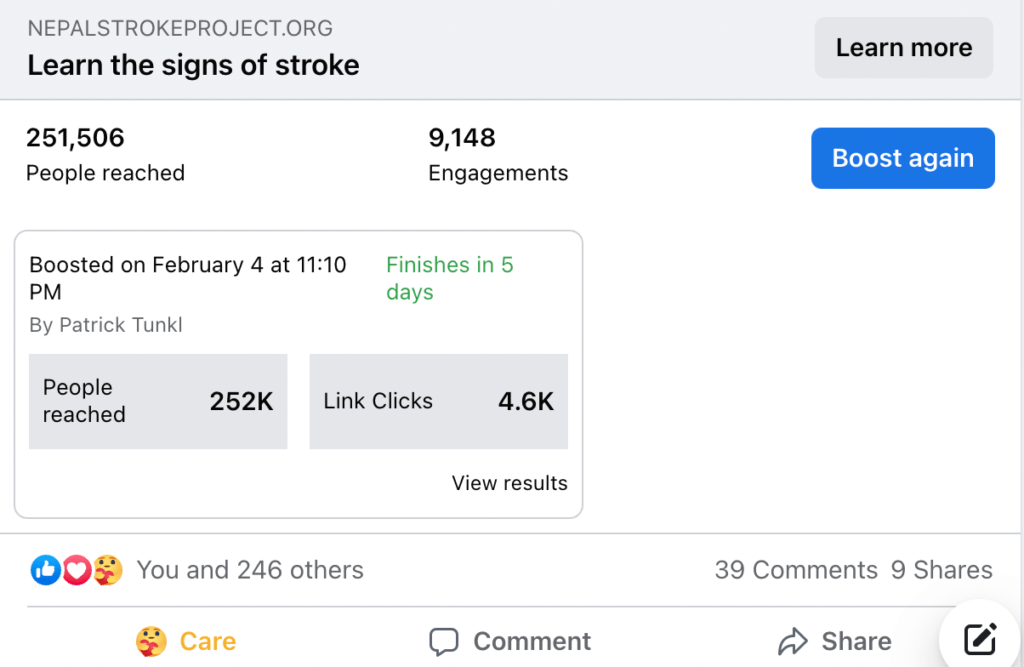
The budget for this was minimal, and the numbers are a factor 10-20x to what I would expect in Europe. So time for a real ad, and the craziness continues:
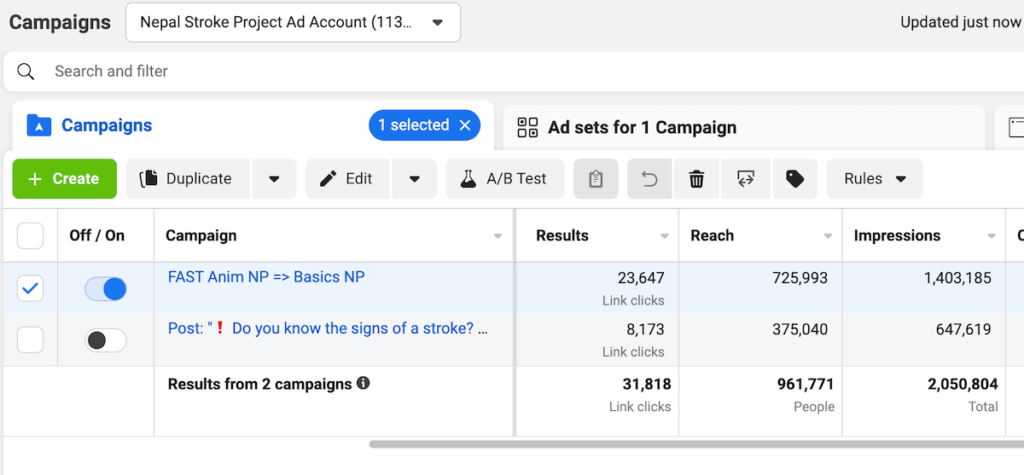
At this point, we knew that we could have a serious quantitative approach to reach people, since the meta network (Facebook, Instagram & Messenger) cover the majority of the reading population of Nepal and the prices are very low.
Using Social Media to reach the right target group
So now we thought about targeting and demographics. With a topic like stroke, what first comes to mind is the gender and age of the stroke patients. The risk of stroke increases with age, so you should focus on older people, right?
Nope, wrong. When it comes to acute stroke, the information is worth most at the „first responder“. So even if grandma has a stroke, it is most likely (especially in the Nepali family context) that the children, grandchildren and overall younger generations will be the ones to recognize the stroke and make the decision to get to the hospital ASAP.
So keeping this is mind, the distribution of demographics suits nicely.
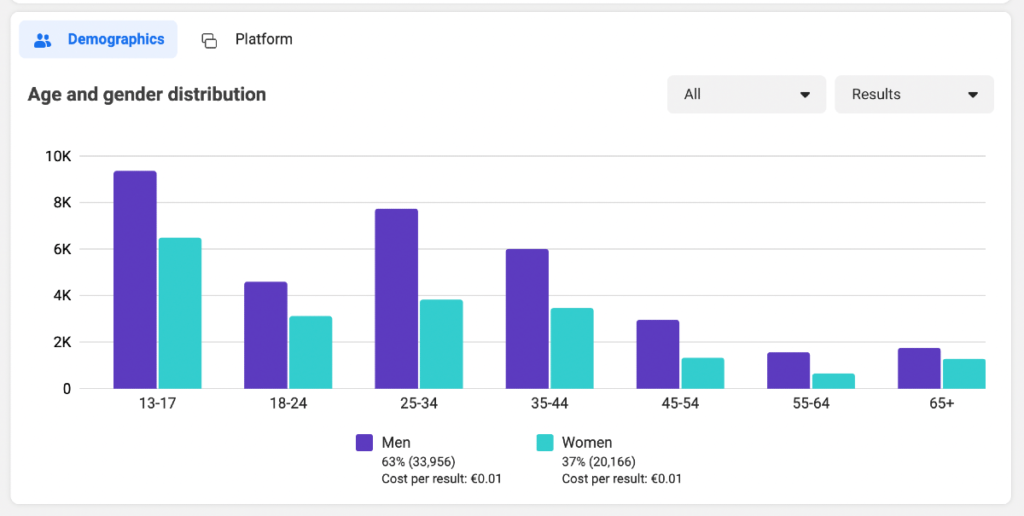
CPC: 0,003€. Yes, that’s the fraction of a cent.
I couldn’t believe it myself. The Click-Action (CPC) – not the view – costs less than a third of a cent.
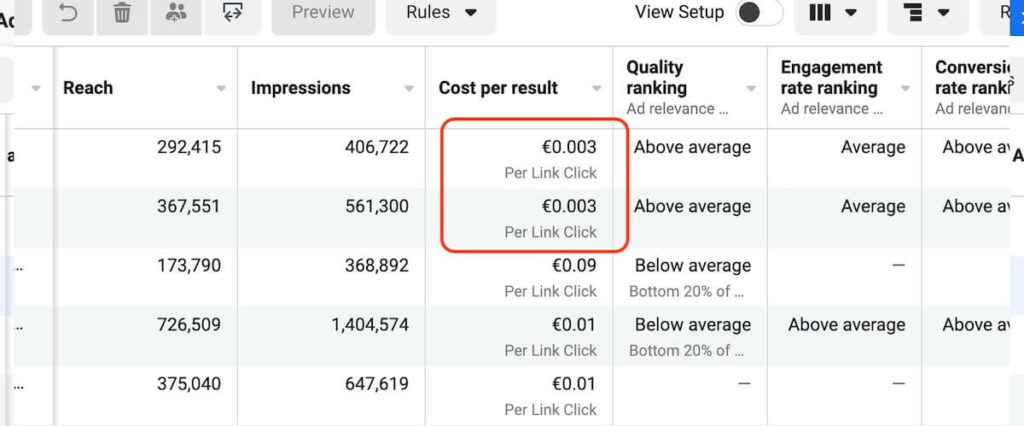
And with CPC like this, you can start thinking in bigger dimensions. Of course, this will rise. So far we are between 1 and 2 cents, but still: This is an option to reach a critical mass of people with the campaign.
With a budget of 100,000 € you could get 1 in 6 Nepali to read the basic information one pager (at a 2 cent CPC). That is just mindblowing. (Of course, there is some exaggeration here: we don’t know if every click is going to read or if the CPC will stay that low when we address a larger number… but you get the idea.) Trying to reach „a whole country“ via social media is simply not really an option in most countries, due to cost. In Nepal, it definitely is! And suppose it will be similar in other lower-to-middle-income countries.
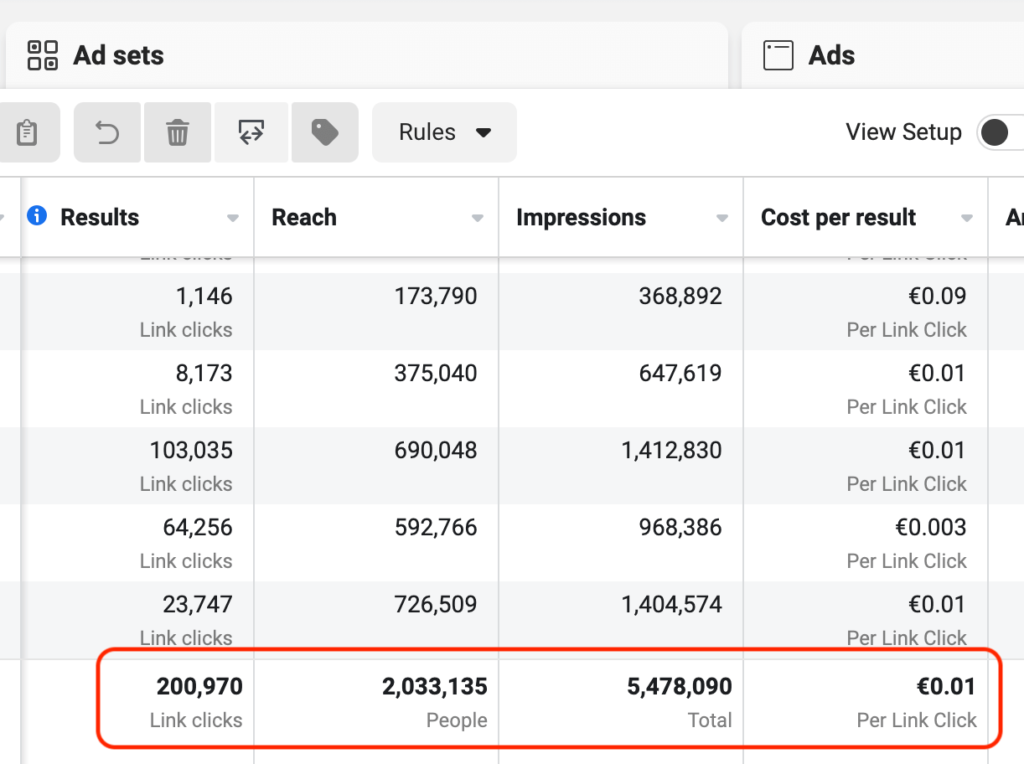
Just to repeat what these numbers (April 2022) mean:
- Reach over 2 million: So two million Nepalese have seen the FAST symbols. (That is almost 7 percent of the population). The Ad was displayed 5,5 Million times for that.
- Link Clicks over 200.000: That means, a fifth of a million wanted further information on stroke and most of them read through a (for the stroke topic quite thorough) page with information.
And all this with with just a little over 1700€ Ad spent. Here’s how that worked:
Having the right materials for creatives
So what is the secret sauce of the 0,003 CPC ad? It is (as it is most of the time) the creative itself. And to not reinvent the wheel, we were allowed by the WSO (World Stroke Organization) to use the unbelievably good materials for the World Stroke Day (Thanks Sarah & Anita!). I just love the picture of un-dissolving people followed by the FAST-Icon-Animations.
These are some next-level creatives.
We just added Nepali translations, since the native translations didn’t cover Nepali. This lead to a very high Quality Ranking and Engagement Rate (see numbers above). Combined with the overall low cost of ads in Nepal, you get the result of a huge number of clicks for very little money.
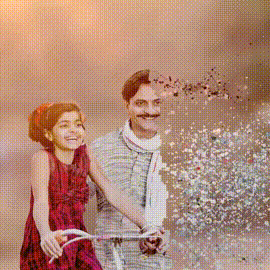
How to continue
As I mentioned above, the cost situation for these ads allow for a bigger scale in Nepal. But before thinking about that, we should do some homework.
Get information if the knowledge stuck
Of course it is nice to see so many people clicking on the „I want more Information“ (or similar) CTA (call to action). But that doesn’t mean that they read all the information on the ‚Basics of Stroke‘ site, nor does it mean that they understood and remembered what they read.
Actually, we used a fraction of the users and did some tracking to see how the information on the onepager is consumed. That led us to remove the accordion („click to expand text“) and write it as plain text – this increased the reading of those text sections there by a multiple. And we know, if we want to increase the number of people sent there, the ‚Basics Page‘ is something that always can and should be optimized.
But for now, can we measure the impact?
Integrate a short quiz to the basic knowledge website
So the next step will be the inclusion of a short quiz-like question on stroke knowledge as a CTA at the end of the page. This could lead to 2 more questions, to get a rough idea, if the people really read the information on the site.
Side effects: Get contact data
And this could be a good point to collect some contact data. This can be a bit tricky (only giving out the results for an email can be effective, but seems to be too much of a dark pattern), also in our experience email is not used in the same manner as in European cultures. So trying to get messenger contacts could be an alternative.
FIN
If you are reading this, thank you very much for your interest! And as you see, there is still a lot to do. If you want to be informed how this is going on, what we did with TikTok, please use the form here and type „Nepal Update“ as subject, and I’ll send you information as soon as there are updates on the campaign.

Thank you Patrick for your effort in spreading the word about Stroke in Nepal!
We hope you return to Nepal soon!